Employability of CvSU Business Management HRM Graduates 2016-2020
VerifiedAdded on 2022/06/07
|48
|14679
|322
Project
AI Summary
This undergraduate thesis proposal investigates the employability of Bachelor of Science in Business Management graduates majoring in Human Resource Management from Cavite State University (CvSU) between 2016 and 2020. The study aims to determine graduates' socio-demographic characteristics, employment status, career intentions, and the relevance of the HRM program curriculum to their chosen occupations. It also assesses the program's contribution to the development of communication, human relations, leadership, problem-solving, and technical skills. The research seeks to address the challenges graduates face in their transition to employment and provides insights into how the university can improve its HRM program to better prepare graduates for the labor market. The study employs a survey questionnaire adapted from CHED's tracer study, with a sample size of 184 graduates, focusing on the main campus of CvSU in Indang, Cavite. The findings are expected to offer valuable information for students, faculty, administrators, and future researchers regarding the employability of CvSU HRM graduates.
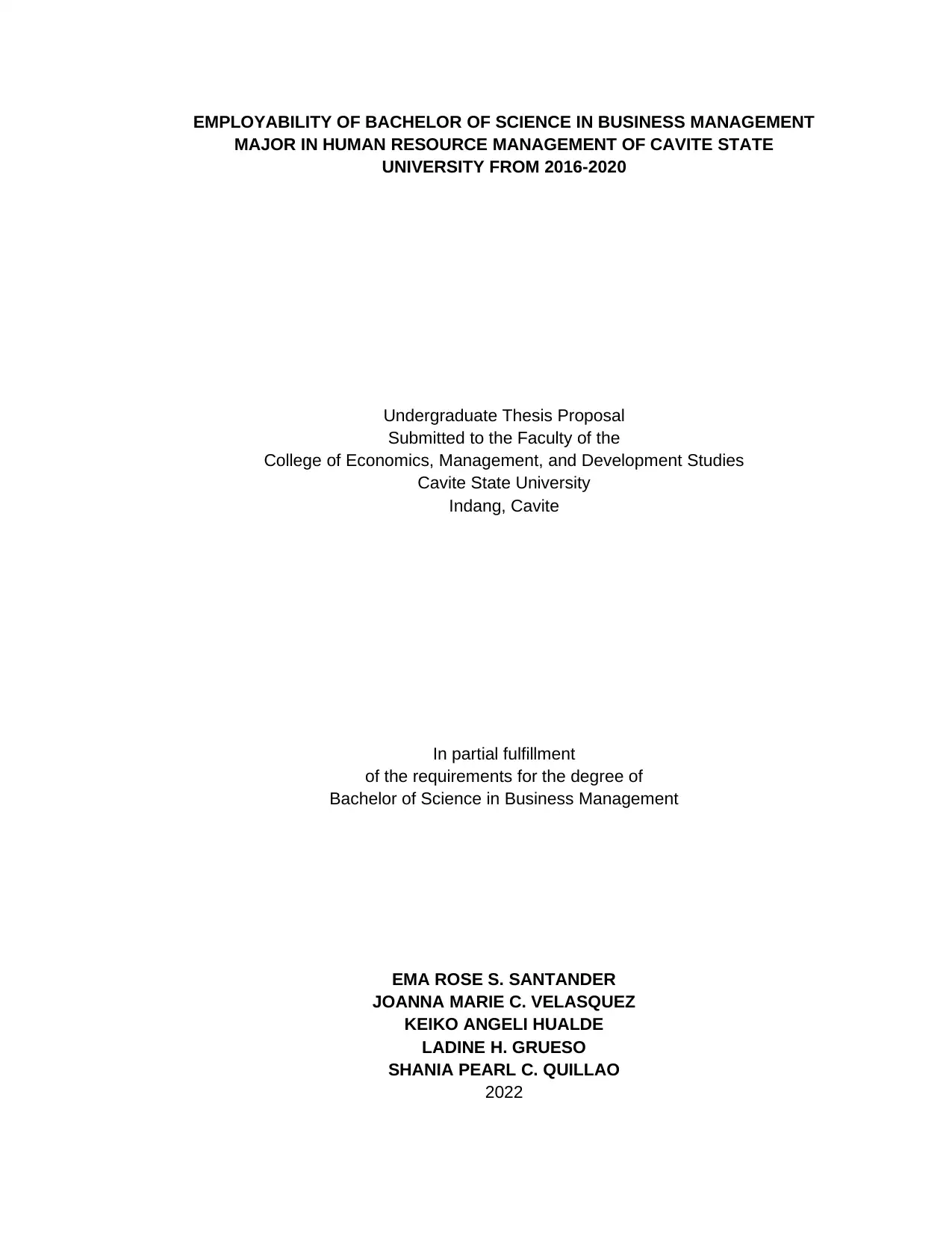
EMPLOYABILITY OF BACHELOR OF SCIENCE IN BUSINESS MANAGEMENT
MAJOR IN HUMAN RESOURCE MANAGEMENT OF CAVITE STATE
UNIVERSITY FROM 2016-2020
Undergraduate Thesis Proposal
Submitted to the Faculty of the
College of Economics, Management, and Development Studies
Cavite State University
Indang, Cavite
In partial fulfillment
of the requirements for the degree of
Bachelor of Science in Business Management
EMA ROSE S. SANTANDER
JOANNA MARIE C. VELASQUEZ
KEIKO ANGELI HUALDE
LADINE H. GRUESO
SHANIA PEARL C. QUILLAO
2022
MAJOR IN HUMAN RESOURCE MANAGEMENT OF CAVITE STATE
UNIVERSITY FROM 2016-2020
Undergraduate Thesis Proposal
Submitted to the Faculty of the
College of Economics, Management, and Development Studies
Cavite State University
Indang, Cavite
In partial fulfillment
of the requirements for the degree of
Bachelor of Science in Business Management
EMA ROSE S. SANTANDER
JOANNA MARIE C. VELASQUEZ
KEIKO ANGELI HUALDE
LADINE H. GRUESO
SHANIA PEARL C. QUILLAO
2022
Paraphrase This Document
Need a fresh take? Get an instant paraphrase of this document with our AI Paraphraser
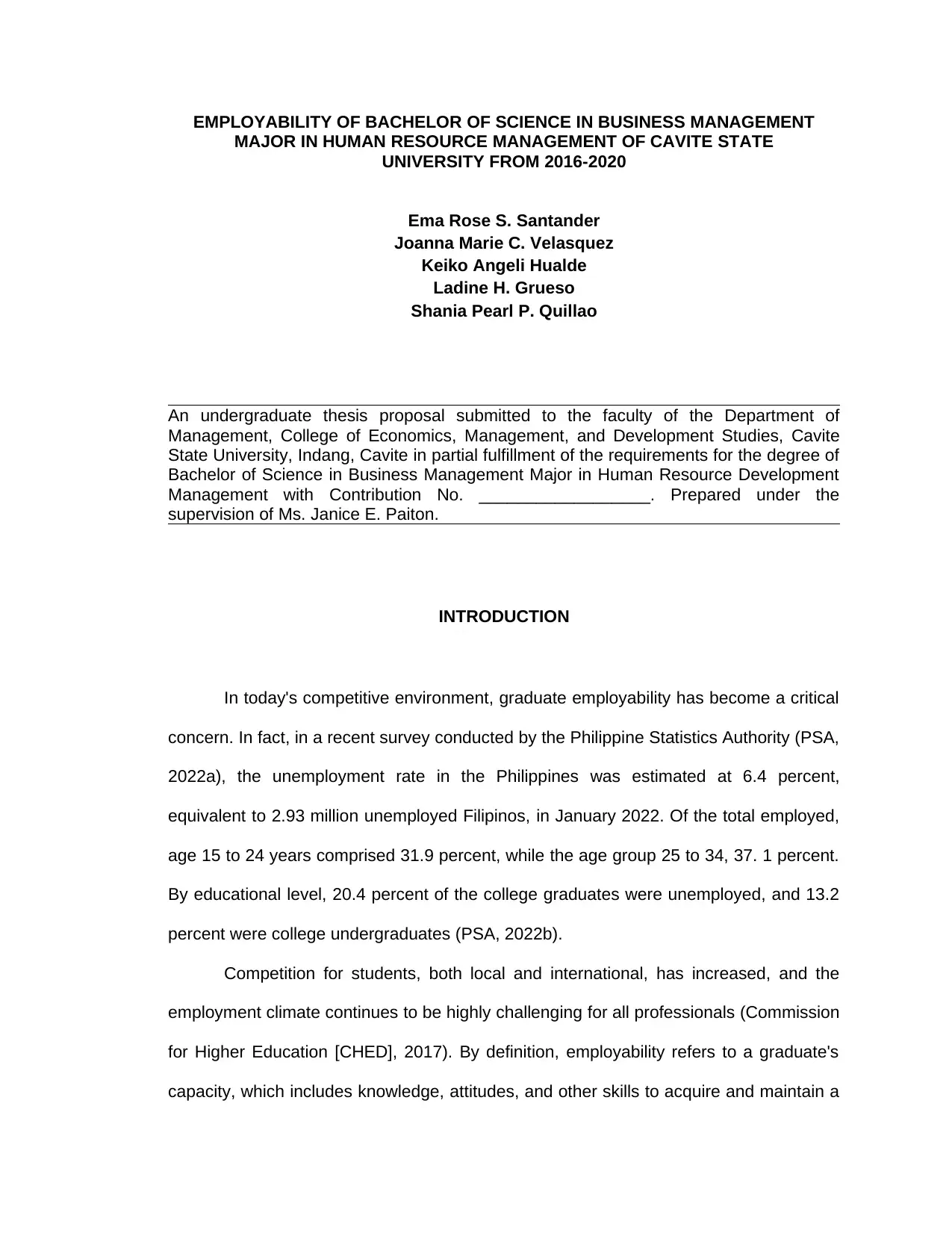
1
EMPLOYABILITY OF BACHELOR OF SCIENCE IN BUSINESS MANAGEMENT
MAJOR IN HUMAN RESOURCE MANAGEMENT OF CAVITE STATE
UNIVERSITY FROM 2016-2020
Ema Rose S. Santander
Joanna Marie C. Velasquez
Keiko Angeli Hualde
Ladine H. Grueso
Shania Pearl P. Quillao
An undergraduate thesis proposal submitted to the faculty of the Department of
Management, College of Economics, Management, and Development Studies, Cavite
State University, Indang, Cavite in partial fulfillment of the requirements for the degree of
Bachelor of Science in Business Management Major in Human Resource Development
Management with Contribution No. __________________. Prepared under the
supervision of Ms. Janice E. Paiton.
INTRODUCTION
In today's competitive environment, graduate employability has become a critical
concern. In fact, in a recent survey conducted by the Philippine Statistics Authority (PSA,
2022a), the unemployment rate in the Philippines was estimated at 6.4 percent,
equivalent to 2.93 million unemployed Filipinos, in January 2022. Of the total employed,
age 15 to 24 years comprised 31.9 percent, while the age group 25 to 34, 37. 1 percent.
By educational level, 20.4 percent of the college graduates were unemployed, and 13.2
percent were college undergraduates (PSA, 2022b).
Competition for students, both local and international, has increased, and the
employment climate continues to be highly challenging for all professionals (Commission
for Higher Education [CHED], 2017). By definition, employability refers to a graduate's
capacity, which includes knowledge, attitudes, and other skills to acquire and maintain a
EMPLOYABILITY OF BACHELOR OF SCIENCE IN BUSINESS MANAGEMENT
MAJOR IN HUMAN RESOURCE MANAGEMENT OF CAVITE STATE
UNIVERSITY FROM 2016-2020
Ema Rose S. Santander
Joanna Marie C. Velasquez
Keiko Angeli Hualde
Ladine H. Grueso
Shania Pearl P. Quillao
An undergraduate thesis proposal submitted to the faculty of the Department of
Management, College of Economics, Management, and Development Studies, Cavite
State University, Indang, Cavite in partial fulfillment of the requirements for the degree of
Bachelor of Science in Business Management Major in Human Resource Development
Management with Contribution No. __________________. Prepared under the
supervision of Ms. Janice E. Paiton.
INTRODUCTION
In today's competitive environment, graduate employability has become a critical
concern. In fact, in a recent survey conducted by the Philippine Statistics Authority (PSA,
2022a), the unemployment rate in the Philippines was estimated at 6.4 percent,
equivalent to 2.93 million unemployed Filipinos, in January 2022. Of the total employed,
age 15 to 24 years comprised 31.9 percent, while the age group 25 to 34, 37. 1 percent.
By educational level, 20.4 percent of the college graduates were unemployed, and 13.2
percent were college undergraduates (PSA, 2022b).
Competition for students, both local and international, has increased, and the
employment climate continues to be highly challenging for all professionals (Commission
for Higher Education [CHED], 2017). By definition, employability refers to a graduate's
capacity, which includes knowledge, attitudes, and other skills to acquire and maintain a
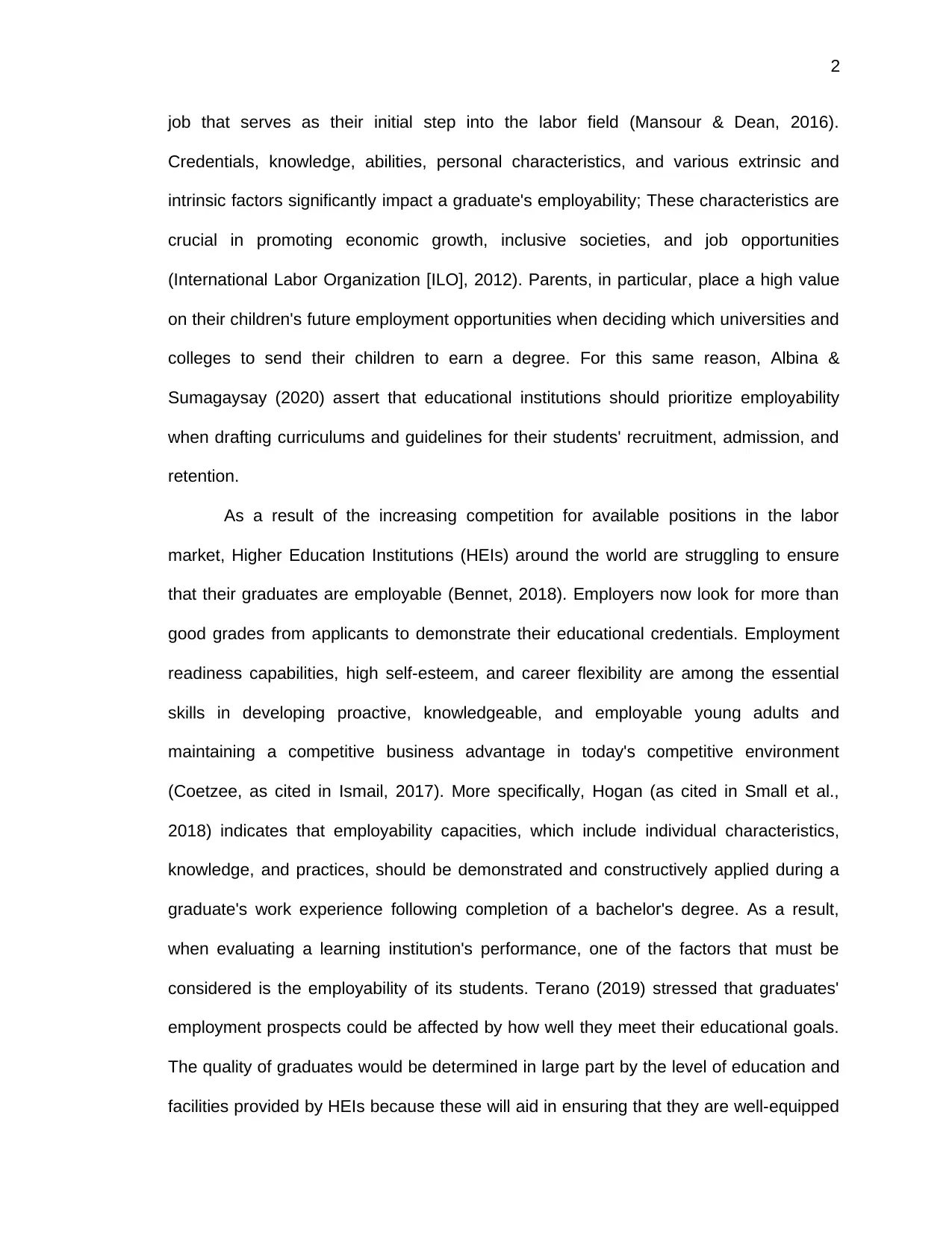
2
job that serves as their initial step into the labor field (Mansour & Dean, 2016).
Credentials, knowledge, abilities, personal characteristics, and various extrinsic and
intrinsic factors significantly impact a graduate's employability; These characteristics are
crucial in promoting economic growth, inclusive societies, and job opportunities
(International Labor Organization [ILO], 2012). Parents, in particular, place a high value
on their children's future employment opportunities when deciding which universities and
colleges to send their children to earn a degree. For this same reason, Albina &
Sumagaysay (2020) assert that educational institutions should prioritize employability
when drafting curriculums and guidelines for their students' recruitment, admission, and
retention.
As a result of the increasing competition for available positions in the labor
market, Higher Education Institutions (HEIs) around the world are struggling to ensure
that their graduates are employable (Bennet, 2018). Employers now look for more than
good grades from applicants to demonstrate their educational credentials. Employment
readiness capabilities, high self-esteem, and career flexibility are among the essential
skills in developing proactive, knowledgeable, and employable young adults and
maintaining a competitive business advantage in today's competitive environment
(Coetzee, as cited in Ismail, 2017). More specifically, Hogan (as cited in Small et al.,
2018) indicates that employability capacities, which include individual characteristics,
knowledge, and practices, should be demonstrated and constructively applied during a
graduate's work experience following completion of a bachelor's degree. As a result,
when evaluating a learning institution's performance, one of the factors that must be
considered is the employability of its students. Terano (2019) stressed that graduates'
employment prospects could be affected by how well they meet their educational goals.
The quality of graduates would be determined in large part by the level of education and
facilities provided by HEIs because these will aid in ensuring that they are well-equipped
job that serves as their initial step into the labor field (Mansour & Dean, 2016).
Credentials, knowledge, abilities, personal characteristics, and various extrinsic and
intrinsic factors significantly impact a graduate's employability; These characteristics are
crucial in promoting economic growth, inclusive societies, and job opportunities
(International Labor Organization [ILO], 2012). Parents, in particular, place a high value
on their children's future employment opportunities when deciding which universities and
colleges to send their children to earn a degree. For this same reason, Albina &
Sumagaysay (2020) assert that educational institutions should prioritize employability
when drafting curriculums and guidelines for their students' recruitment, admission, and
retention.
As a result of the increasing competition for available positions in the labor
market, Higher Education Institutions (HEIs) around the world are struggling to ensure
that their graduates are employable (Bennet, 2018). Employers now look for more than
good grades from applicants to demonstrate their educational credentials. Employment
readiness capabilities, high self-esteem, and career flexibility are among the essential
skills in developing proactive, knowledgeable, and employable young adults and
maintaining a competitive business advantage in today's competitive environment
(Coetzee, as cited in Ismail, 2017). More specifically, Hogan (as cited in Small et al.,
2018) indicates that employability capacities, which include individual characteristics,
knowledge, and practices, should be demonstrated and constructively applied during a
graduate's work experience following completion of a bachelor's degree. As a result,
when evaluating a learning institution's performance, one of the factors that must be
considered is the employability of its students. Terano (2019) stressed that graduates'
employment prospects could be affected by how well they meet their educational goals.
The quality of graduates would be determined in large part by the level of education and
facilities provided by HEIs because these will aid in ensuring that they are well-equipped
⊘ This is a preview!⊘
Do you want full access?
Subscribe today to unlock all pages.

Trusted by 1+ million students worldwide
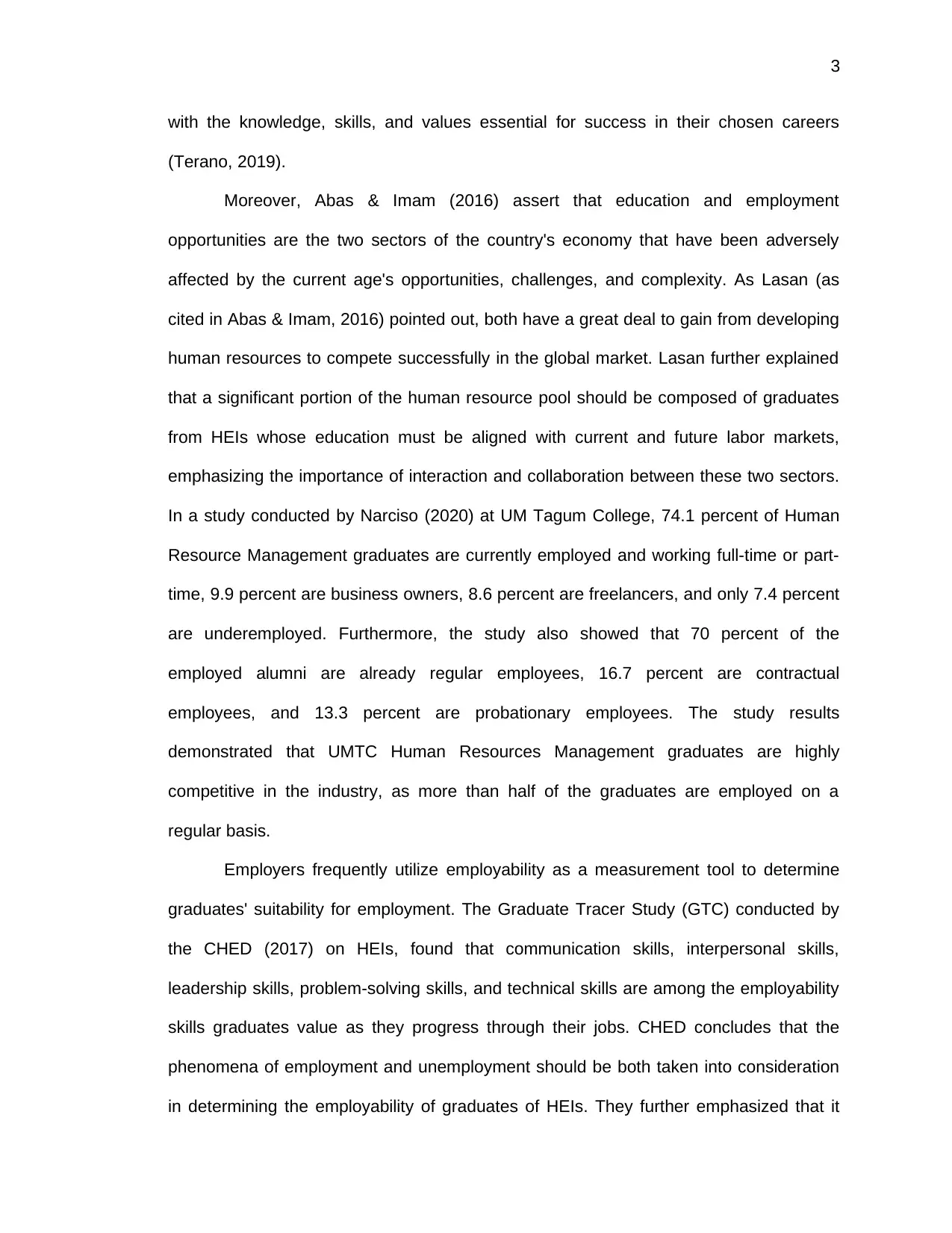
3
with the knowledge, skills, and values essential for success in their chosen careers
(Terano, 2019).
Moreover, Abas & Imam (2016) assert that education and employment
opportunities are the two sectors of the country's economy that have been adversely
affected by the current age's opportunities, challenges, and complexity. As Lasan (as
cited in Abas & Imam, 2016) pointed out, both have a great deal to gain from developing
human resources to compete successfully in the global market. Lasan further explained
that a significant portion of the human resource pool should be composed of graduates
from HEIs whose education must be aligned with current and future labor markets,
emphasizing the importance of interaction and collaboration between these two sectors.
In a study conducted by Narciso (2020) at UM Tagum College, 74.1 percent of Human
Resource Management graduates are currently employed and working full-time or part-
time, 9.9 percent are business owners, 8.6 percent are freelancers, and only 7.4 percent
are underemployed. Furthermore, the study also showed that 70 percent of the
employed alumni are already regular employees, 16.7 percent are contractual
employees, and 13.3 percent are probationary employees. The study results
demonstrated that UMTC Human Resources Management graduates are highly
competitive in the industry, as more than half of the graduates are employed on a
regular basis.
Employers frequently utilize employability as a measurement tool to determine
graduates' suitability for employment. The Graduate Tracer Study (GTC) conducted by
the CHED (2017) on HEIs, found that communication skills, interpersonal skills,
leadership skills, problem-solving skills, and technical skills are among the employability
skills graduates value as they progress through their jobs. CHED concludes that the
phenomena of employment and unemployment should be both taken into consideration
in determining the employability of graduates of HEIs. They further emphasized that it
with the knowledge, skills, and values essential for success in their chosen careers
(Terano, 2019).
Moreover, Abas & Imam (2016) assert that education and employment
opportunities are the two sectors of the country's economy that have been adversely
affected by the current age's opportunities, challenges, and complexity. As Lasan (as
cited in Abas & Imam, 2016) pointed out, both have a great deal to gain from developing
human resources to compete successfully in the global market. Lasan further explained
that a significant portion of the human resource pool should be composed of graduates
from HEIs whose education must be aligned with current and future labor markets,
emphasizing the importance of interaction and collaboration between these two sectors.
In a study conducted by Narciso (2020) at UM Tagum College, 74.1 percent of Human
Resource Management graduates are currently employed and working full-time or part-
time, 9.9 percent are business owners, 8.6 percent are freelancers, and only 7.4 percent
are underemployed. Furthermore, the study also showed that 70 percent of the
employed alumni are already regular employees, 16.7 percent are contractual
employees, and 13.3 percent are probationary employees. The study results
demonstrated that UMTC Human Resources Management graduates are highly
competitive in the industry, as more than half of the graduates are employed on a
regular basis.
Employers frequently utilize employability as a measurement tool to determine
graduates' suitability for employment. The Graduate Tracer Study (GTC) conducted by
the CHED (2017) on HEIs, found that communication skills, interpersonal skills,
leadership skills, problem-solving skills, and technical skills are among the employability
skills graduates value as they progress through their jobs. CHED concludes that the
phenomena of employment and unemployment should be both taken into consideration
in determining the employability of graduates of HEIs. They further emphasized that it
Paraphrase This Document
Need a fresh take? Get an instant paraphrase of this document with our AI Paraphraser
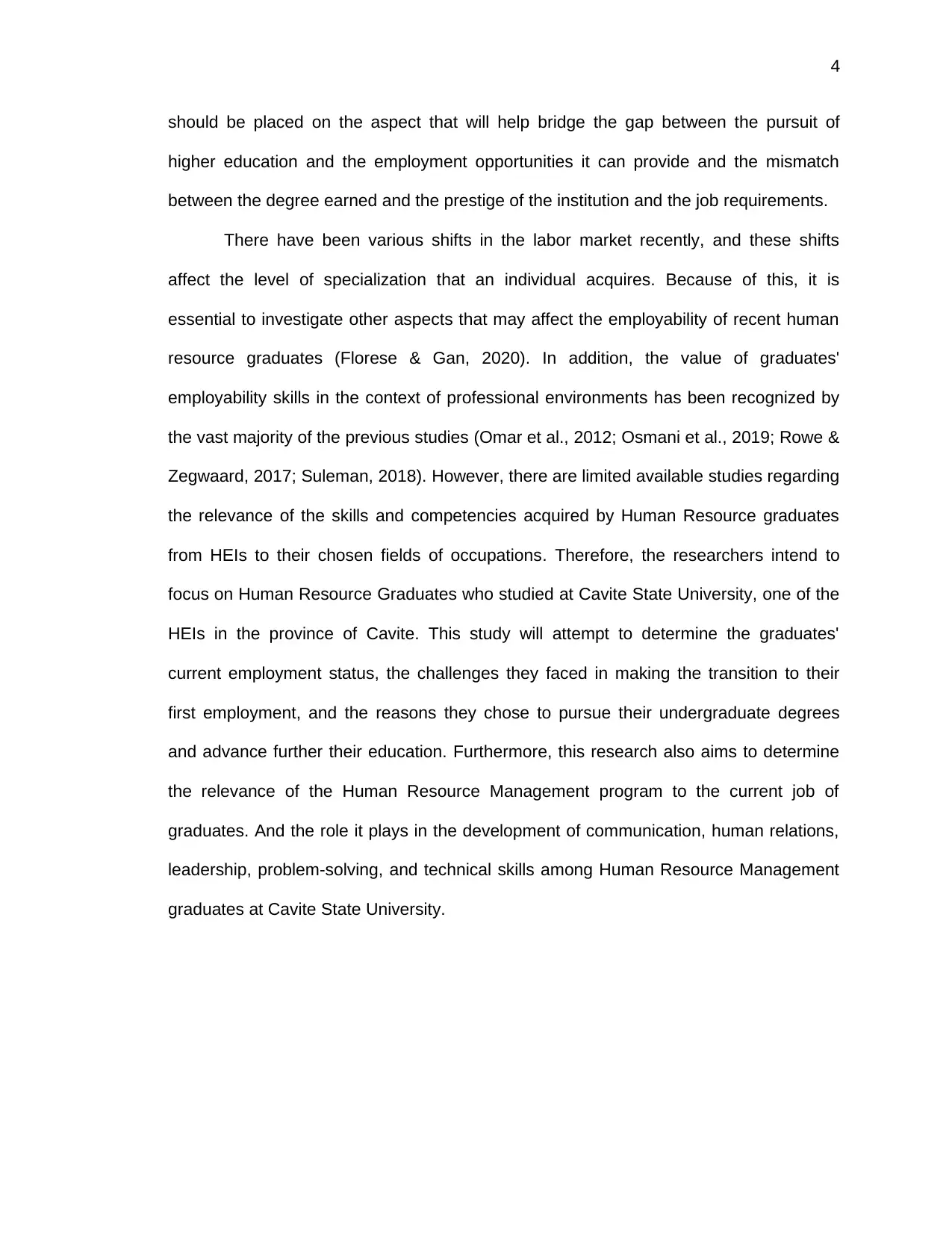
4
should be placed on the aspect that will help bridge the gap between the pursuit of
higher education and the employment opportunities it can provide and the mismatch
between the degree earned and the prestige of the institution and the job requirements.
There have been various shifts in the labor market recently, and these shifts
affect the level of specialization that an individual acquires. Because of this, it is
essential to investigate other aspects that may affect the employability of recent human
resource graduates (Florese & Gan, 2020). In addition, the value of graduates'
employability skills in the context of professional environments has been recognized by
the vast majority of the previous studies (Omar et al., 2012; Osmani et al., 2019; Rowe &
Zegwaard, 2017; Suleman, 2018). However, there are limited available studies regarding
the relevance of the skills and competencies acquired by Human Resource graduates
from HEIs to their chosen fields of occupations. Therefore, the researchers intend to
focus on Human Resource Graduates who studied at Cavite State University, one of the
HEIs in the province of Cavite. This study will attempt to determine the graduates'
current employment status, the challenges they faced in making the transition to their
first employment, and the reasons they chose to pursue their undergraduate degrees
and advance further their education. Furthermore, this research also aims to determine
the relevance of the Human Resource Management program to the current job of
graduates. And the role it plays in the development of communication, human relations,
leadership, problem-solving, and technical skills among Human Resource Management
graduates at Cavite State University.
should be placed on the aspect that will help bridge the gap between the pursuit of
higher education and the employment opportunities it can provide and the mismatch
between the degree earned and the prestige of the institution and the job requirements.
There have been various shifts in the labor market recently, and these shifts
affect the level of specialization that an individual acquires. Because of this, it is
essential to investigate other aspects that may affect the employability of recent human
resource graduates (Florese & Gan, 2020). In addition, the value of graduates'
employability skills in the context of professional environments has been recognized by
the vast majority of the previous studies (Omar et al., 2012; Osmani et al., 2019; Rowe &
Zegwaard, 2017; Suleman, 2018). However, there are limited available studies regarding
the relevance of the skills and competencies acquired by Human Resource graduates
from HEIs to their chosen fields of occupations. Therefore, the researchers intend to
focus on Human Resource Graduates who studied at Cavite State University, one of the
HEIs in the province of Cavite. This study will attempt to determine the graduates'
current employment status, the challenges they faced in making the transition to their
first employment, and the reasons they chose to pursue their undergraduate degrees
and advance further their education. Furthermore, this research also aims to determine
the relevance of the Human Resource Management program to the current job of
graduates. And the role it plays in the development of communication, human relations,
leadership, problem-solving, and technical skills among Human Resource Management
graduates at Cavite State University.
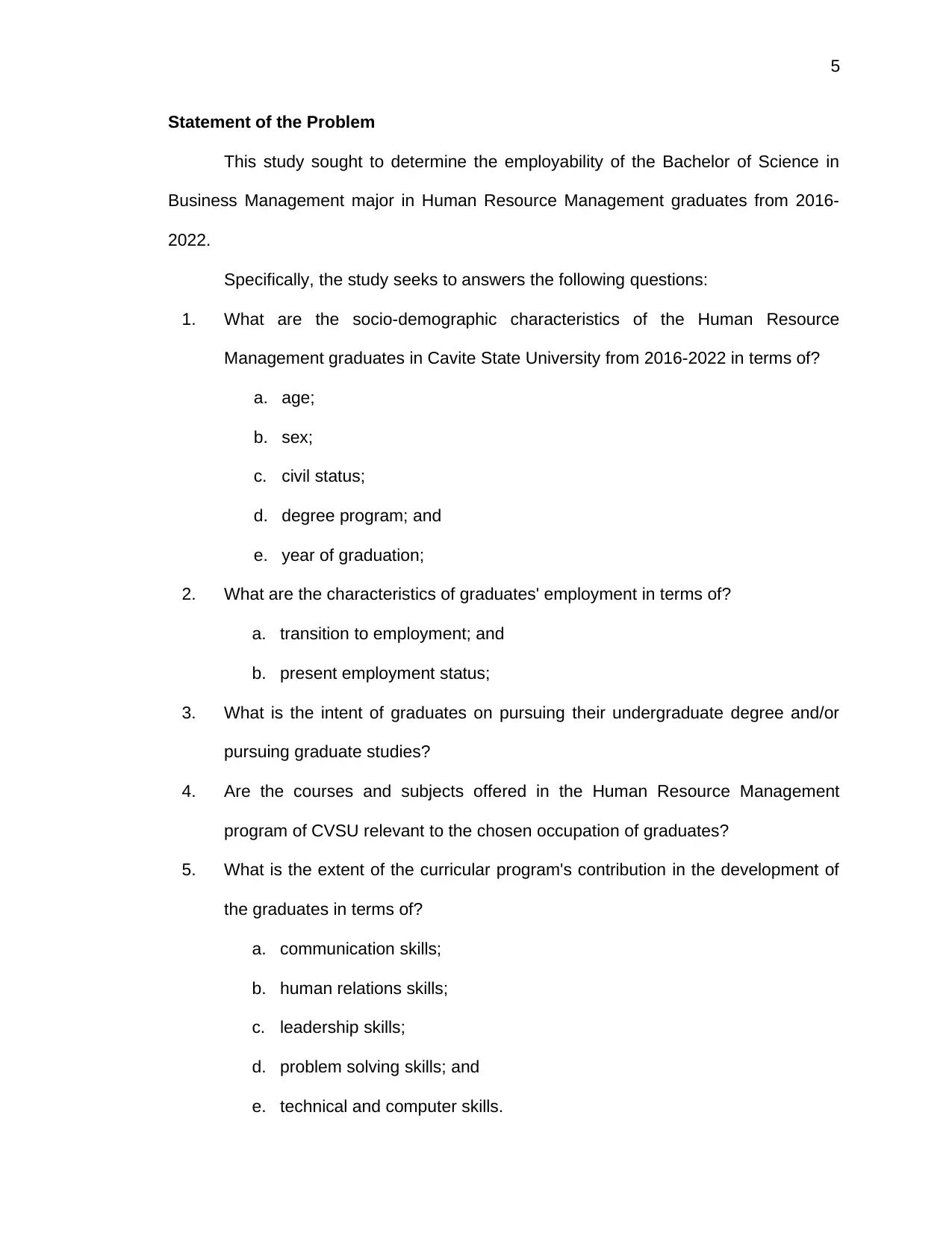
5
Statement of the Problem
This study sought to determine the employability of the Bachelor of Science in
Business Management major in Human Resource Management graduates from 2016-
2022.
Specifically, the study seeks to answers the following questions:
1. What are the socio-demographic characteristics of the Human Resource
Management graduates in Cavite State University from 2016-2022 in terms of?
a. age;
b. sex;
c. civil status;
d. degree program; and
e. year of graduation;
2. What are the characteristics of graduates' employment in terms of?
a. transition to employment; and
b. present employment status;
3. What is the intent of graduates on pursuing their undergraduate degree and/or
pursuing graduate studies?
4. Are the courses and subjects offered in the Human Resource Management
program of CVSU relevant to the chosen occupation of graduates?
5. What is the extent of the curricular program's contribution in the development of
the graduates in terms of?
a. communication skills;
b. human relations skills;
c. leadership skills;
d. problem solving skills; and
e. technical and computer skills.
Statement of the Problem
This study sought to determine the employability of the Bachelor of Science in
Business Management major in Human Resource Management graduates from 2016-
2022.
Specifically, the study seeks to answers the following questions:
1. What are the socio-demographic characteristics of the Human Resource
Management graduates in Cavite State University from 2016-2022 in terms of?
a. age;
b. sex;
c. civil status;
d. degree program; and
e. year of graduation;
2. What are the characteristics of graduates' employment in terms of?
a. transition to employment; and
b. present employment status;
3. What is the intent of graduates on pursuing their undergraduate degree and/or
pursuing graduate studies?
4. Are the courses and subjects offered in the Human Resource Management
program of CVSU relevant to the chosen occupation of graduates?
5. What is the extent of the curricular program's contribution in the development of
the graduates in terms of?
a. communication skills;
b. human relations skills;
c. leadership skills;
d. problem solving skills; and
e. technical and computer skills.
⊘ This is a preview!⊘
Do you want full access?
Subscribe today to unlock all pages.

Trusted by 1+ million students worldwide
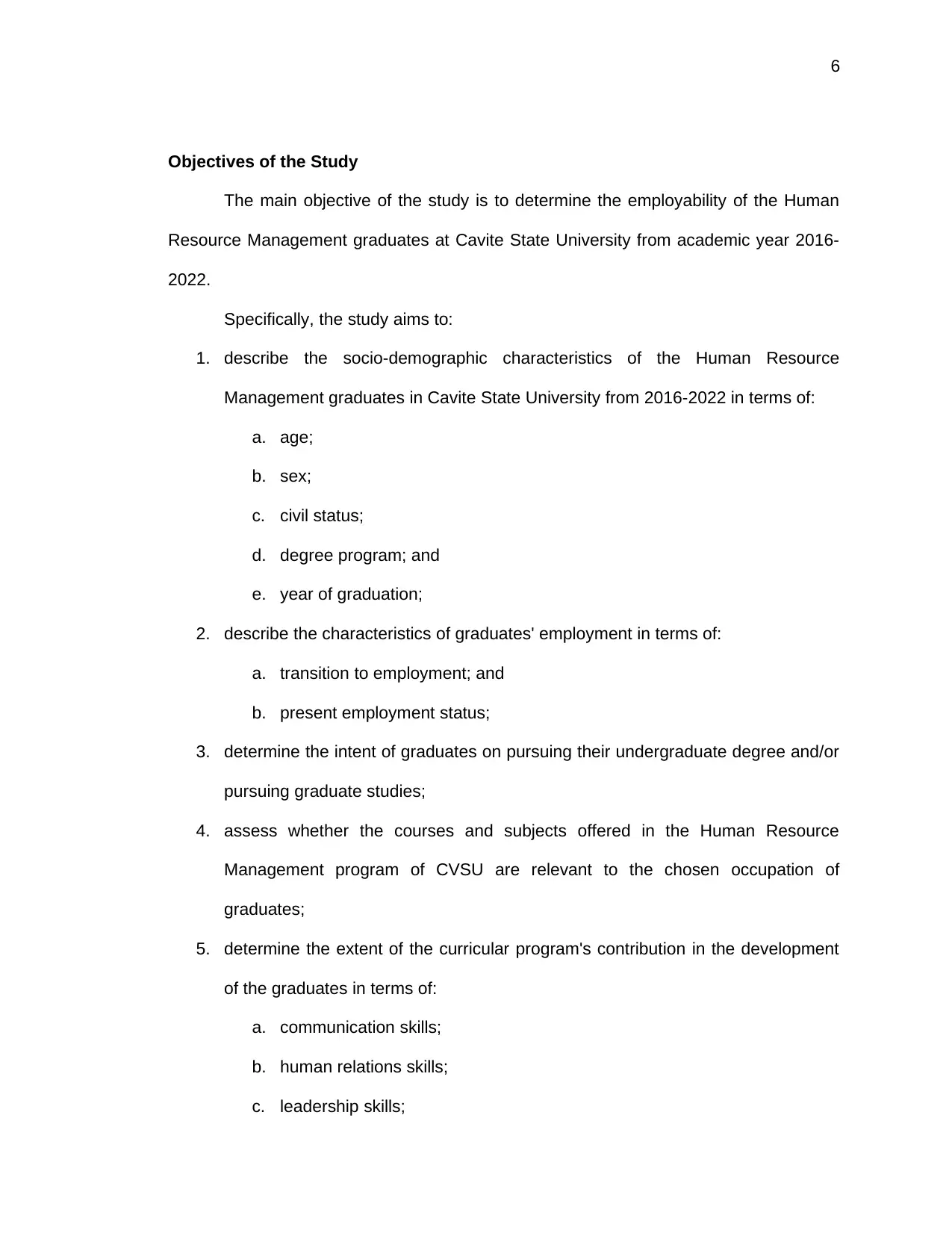
6
Objectives of the Study
The main objective of the study is to determine the employability of the Human
Resource Management graduates at Cavite State University from academic year 2016-
2022.
Specifically, the study aims to:
1. describe the socio-demographic characteristics of the Human Resource
Management graduates in Cavite State University from 2016-2022 in terms of:
a. age;
b. sex;
c. civil status;
d. degree program; and
e. year of graduation;
2. describe the characteristics of graduates' employment in terms of:
a. transition to employment; and
b. present employment status;
3. determine the intent of graduates on pursuing their undergraduate degree and/or
pursuing graduate studies;
4. assess whether the courses and subjects offered in the Human Resource
Management program of CVSU are relevant to the chosen occupation of
graduates;
5. determine the extent of the curricular program's contribution in the development
of the graduates in terms of:
a. communication skills;
b. human relations skills;
c. leadership skills;
Objectives of the Study
The main objective of the study is to determine the employability of the Human
Resource Management graduates at Cavite State University from academic year 2016-
2022.
Specifically, the study aims to:
1. describe the socio-demographic characteristics of the Human Resource
Management graduates in Cavite State University from 2016-2022 in terms of:
a. age;
b. sex;
c. civil status;
d. degree program; and
e. year of graduation;
2. describe the characteristics of graduates' employment in terms of:
a. transition to employment; and
b. present employment status;
3. determine the intent of graduates on pursuing their undergraduate degree and/or
pursuing graduate studies;
4. assess whether the courses and subjects offered in the Human Resource
Management program of CVSU are relevant to the chosen occupation of
graduates;
5. determine the extent of the curricular program's contribution in the development
of the graduates in terms of:
a. communication skills;
b. human relations skills;
c. leadership skills;
Paraphrase This Document
Need a fresh take? Get an instant paraphrase of this document with our AI Paraphraser
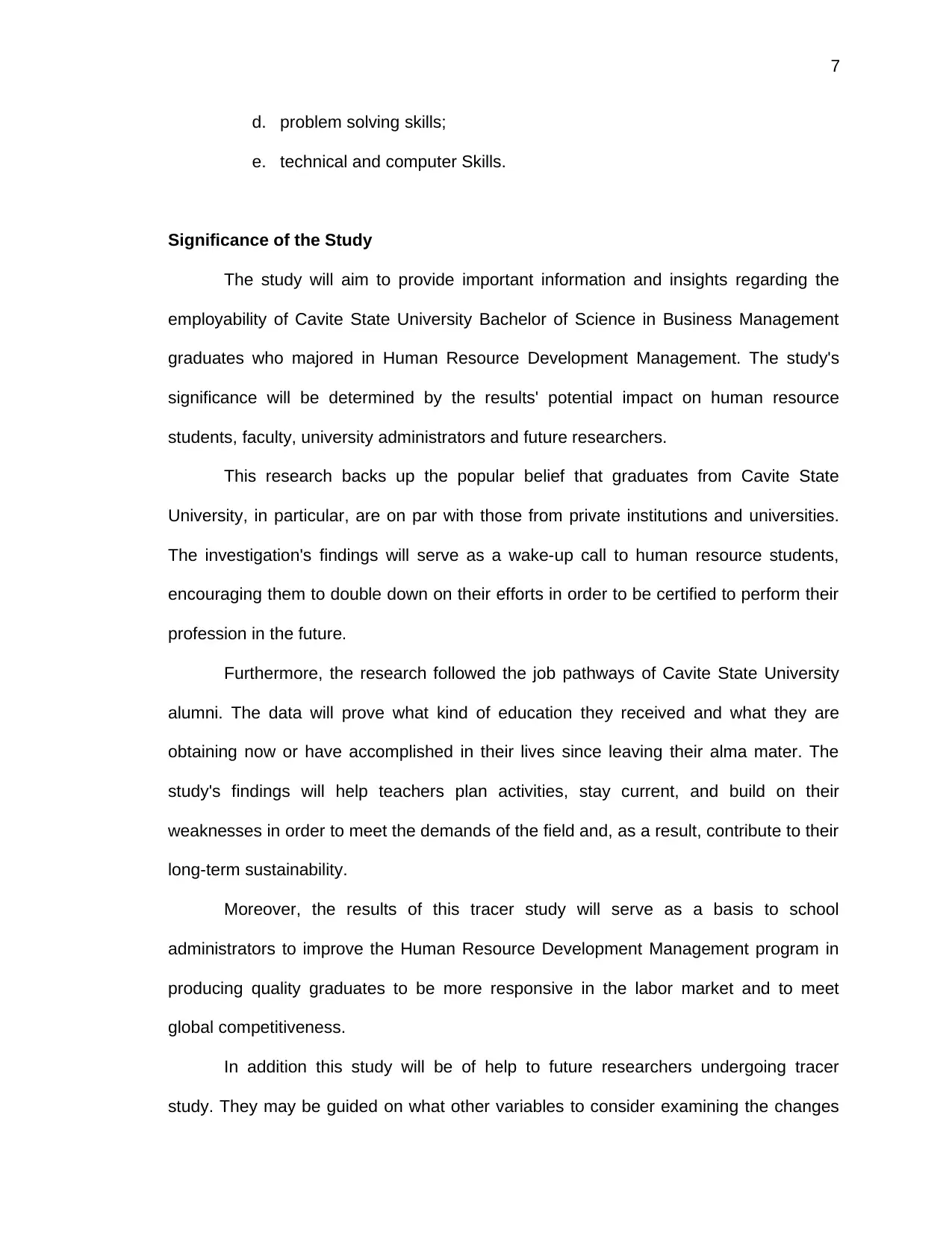
7
d. problem solving skills;
e. technical and computer Skills.
Significance of the Study
The study will aim to provide important information and insights regarding the
employability of Cavite State University Bachelor of Science in Business Management
graduates who majored in Human Resource Development Management. The study's
significance will be determined by the results' potential impact on human resource
students, faculty, university administrators and future researchers.
This research backs up the popular belief that graduates from Cavite State
University, in particular, are on par with those from private institutions and universities.
The investigation's findings will serve as a wake-up call to human resource students,
encouraging them to double down on their efforts in order to be certified to perform their
profession in the future.
Furthermore, the research followed the job pathways of Cavite State University
alumni. The data will prove what kind of education they received and what they are
obtaining now or have accomplished in their lives since leaving their alma mater. The
study's findings will help teachers plan activities, stay current, and build on their
weaknesses in order to meet the demands of the field and, as a result, contribute to their
long-term sustainability.
Moreover, the results of this tracer study will serve as a basis to school
administrators to improve the Human Resource Development Management program in
producing quality graduates to be more responsive in the labor market and to meet
global competitiveness.
In addition this study will be of help to future researchers undergoing tracer
study. They may be guided on what other variables to consider examining the changes
d. problem solving skills;
e. technical and computer Skills.
Significance of the Study
The study will aim to provide important information and insights regarding the
employability of Cavite State University Bachelor of Science in Business Management
graduates who majored in Human Resource Development Management. The study's
significance will be determined by the results' potential impact on human resource
students, faculty, university administrators and future researchers.
This research backs up the popular belief that graduates from Cavite State
University, in particular, are on par with those from private institutions and universities.
The investigation's findings will serve as a wake-up call to human resource students,
encouraging them to double down on their efforts in order to be certified to perform their
profession in the future.
Furthermore, the research followed the job pathways of Cavite State University
alumni. The data will prove what kind of education they received and what they are
obtaining now or have accomplished in their lives since leaving their alma mater. The
study's findings will help teachers plan activities, stay current, and build on their
weaknesses in order to meet the demands of the field and, as a result, contribute to their
long-term sustainability.
Moreover, the results of this tracer study will serve as a basis to school
administrators to improve the Human Resource Development Management program in
producing quality graduates to be more responsive in the labor market and to meet
global competitiveness.
In addition this study will be of help to future researchers undergoing tracer
study. They may be guided on what other variables to consider examining the changes
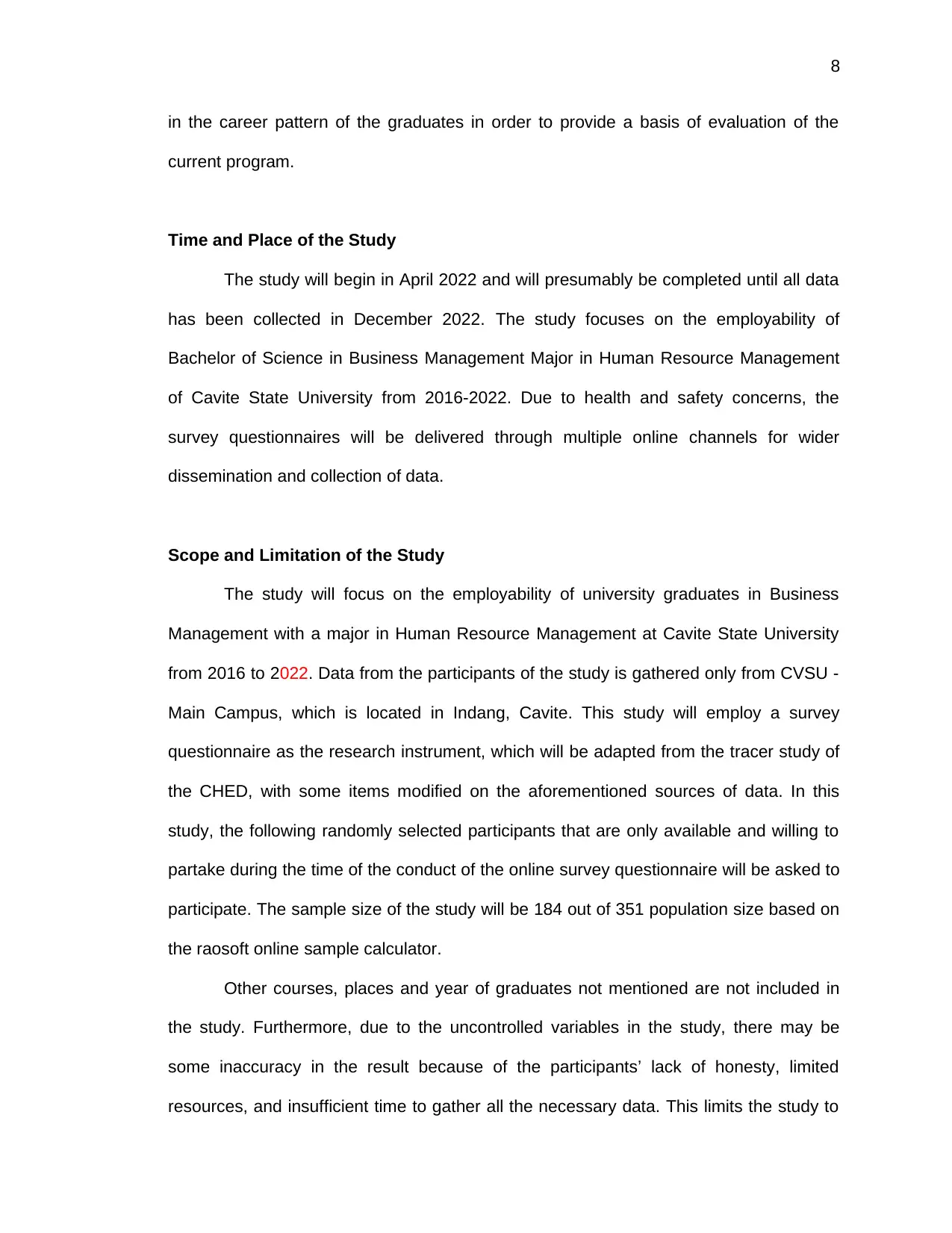
8
in the career pattern of the graduates in order to provide a basis of evaluation of the
current program.
Time and Place of the Study
The study will begin in April 2022 and will presumably be completed until all data
has been collected in December 2022. The study focuses on the employability of
Bachelor of Science in Business Management Major in Human Resource Management
of Cavite State University from 2016-2022. Due to health and safety concerns, the
survey questionnaires will be delivered through multiple online channels for wider
dissemination and collection of data.
Scope and Limitation of the Study
The study will focus on the employability of university graduates in Business
Management with a major in Human Resource Management at Cavite State University
from 2016 to 2022. Data from the participants of the study is gathered only from CVSU -
Main Campus, which is located in Indang, Cavite. This study will employ a survey
questionnaire as the research instrument, which will be adapted from the tracer study of
the CHED, with some items modified on the aforementioned sources of data. In this
study, the following randomly selected participants that are only available and willing to
partake during the time of the conduct of the online survey questionnaire will be asked to
participate. The sample size of the study will be 184 out of 351 population size based on
the raosoft online sample calculator.
Other courses, places and year of graduates not mentioned are not included in
the study. Furthermore, due to the uncontrolled variables in the study, there may be
some inaccuracy in the result because of the participants’ lack of honesty, limited
resources, and insufficient time to gather all the necessary data. This limits the study to
in the career pattern of the graduates in order to provide a basis of evaluation of the
current program.
Time and Place of the Study
The study will begin in April 2022 and will presumably be completed until all data
has been collected in December 2022. The study focuses on the employability of
Bachelor of Science in Business Management Major in Human Resource Management
of Cavite State University from 2016-2022. Due to health and safety concerns, the
survey questionnaires will be delivered through multiple online channels for wider
dissemination and collection of data.
Scope and Limitation of the Study
The study will focus on the employability of university graduates in Business
Management with a major in Human Resource Management at Cavite State University
from 2016 to 2022. Data from the participants of the study is gathered only from CVSU -
Main Campus, which is located in Indang, Cavite. This study will employ a survey
questionnaire as the research instrument, which will be adapted from the tracer study of
the CHED, with some items modified on the aforementioned sources of data. In this
study, the following randomly selected participants that are only available and willing to
partake during the time of the conduct of the online survey questionnaire will be asked to
participate. The sample size of the study will be 184 out of 351 population size based on
the raosoft online sample calculator.
Other courses, places and year of graduates not mentioned are not included in
the study. Furthermore, due to the uncontrolled variables in the study, there may be
some inaccuracy in the result because of the participants’ lack of honesty, limited
resources, and insufficient time to gather all the necessary data. This limits the study to
⊘ This is a preview!⊘
Do you want full access?
Subscribe today to unlock all pages.

Trusted by 1+ million students worldwide
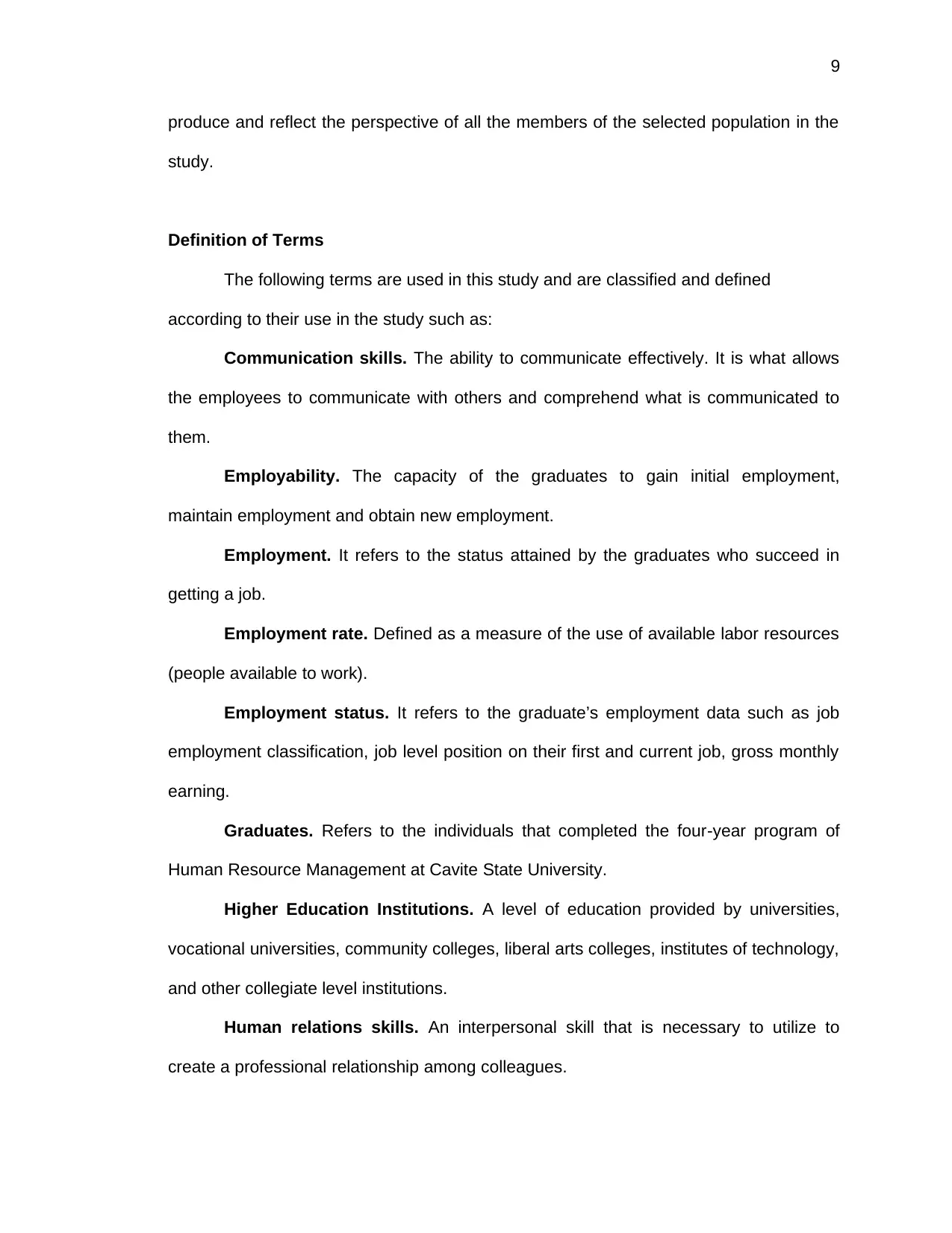
9
produce and reflect the perspective of all the members of the selected population in the
study.
Definition of Terms
The following terms are used in this study and are classified and defined
according to their use in the study such as:
Communication skills. The ability to communicate effectively. It is what allows
the employees to communicate with others and comprehend what is communicated to
them.
Employability. The capacity of the graduates to gain initial employment,
maintain employment and obtain new employment.
Employment. It refers to the status attained by the graduates who succeed in
getting a job.
Employment rate. Defined as a measure of the use of available labor resources
(people available to work).
Employment status. It refers to the graduate’s employment data such as job
employment classification, job level position on their first and current job, gross monthly
earning.
Graduates. Refers to the individuals that completed the four-year program of
Human Resource Management at Cavite State University.
Higher Education Institutions. A level of education provided by universities,
vocational universities, community colleges, liberal arts colleges, institutes of technology,
and other collegiate level institutions.
Human relations skills. An interpersonal skill that is necessary to utilize to
create a professional relationship among colleagues.
produce and reflect the perspective of all the members of the selected population in the
study.
Definition of Terms
The following terms are used in this study and are classified and defined
according to their use in the study such as:
Communication skills. The ability to communicate effectively. It is what allows
the employees to communicate with others and comprehend what is communicated to
them.
Employability. The capacity of the graduates to gain initial employment,
maintain employment and obtain new employment.
Employment. It refers to the status attained by the graduates who succeed in
getting a job.
Employment rate. Defined as a measure of the use of available labor resources
(people available to work).
Employment status. It refers to the graduate’s employment data such as job
employment classification, job level position on their first and current job, gross monthly
earning.
Graduates. Refers to the individuals that completed the four-year program of
Human Resource Management at Cavite State University.
Higher Education Institutions. A level of education provided by universities,
vocational universities, community colleges, liberal arts colleges, institutes of technology,
and other collegiate level institutions.
Human relations skills. An interpersonal skill that is necessary to utilize to
create a professional relationship among colleagues.
Paraphrase This Document
Need a fresh take? Get an instant paraphrase of this document with our AI Paraphraser
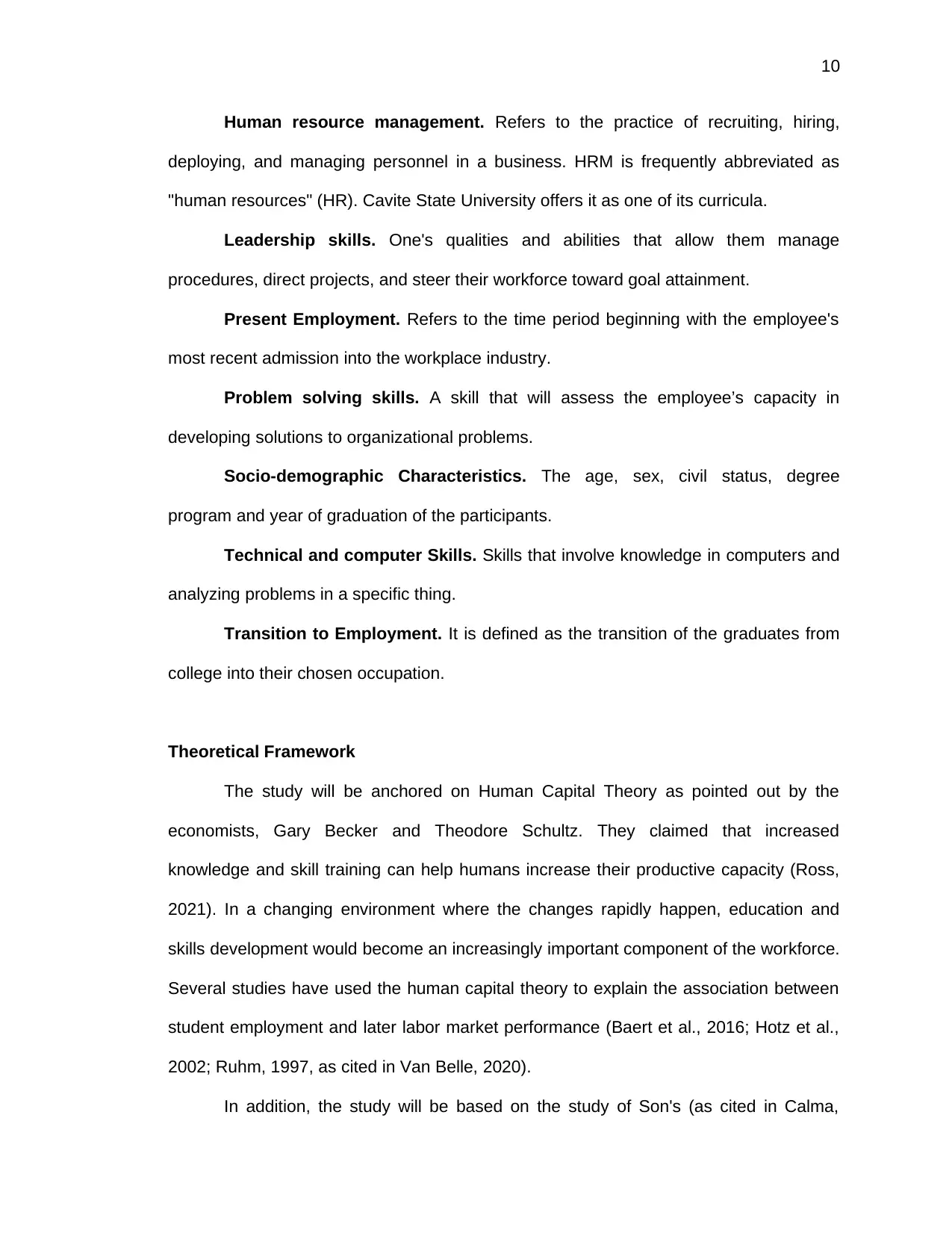
10
Human resource management. Refers to the practice of recruiting, hiring,
deploying, and managing personnel in a business. HRM is frequently abbreviated as
"human resources" (HR). Cavite State University offers it as one of its curricula.
Leadership skills. One's qualities and abilities that allow them manage
procedures, direct projects, and steer their workforce toward goal attainment.
Present Employment. Refers to the time period beginning with the employee's
most recent admission into the workplace industry.
Problem solving skills. A skill that will assess the employee’s capacity in
developing solutions to organizational problems.
Socio-demographic Characteristics. The age, sex, civil status, degree
program and year of graduation of the participants.
Technical and computer Skills. Skills that involve knowledge in computers and
analyzing problems in a specific thing.
Transition to Employment. It is defined as the transition of the graduates from
college into their chosen occupation.
Theoretical Framework
The study will be anchored on Human Capital Theory as pointed out by the
economists, Gary Becker and Theodore Schultz. They claimed that increased
knowledge and skill training can help humans increase their productive capacity (Ross,
2021). In a changing environment where the changes rapidly happen, education and
skills development would become an increasingly important component of the workforce.
Several studies have used the human capital theory to explain the association between
student employment and later labor market performance (Baert et al., 2016; Hotz et al.,
2002; Ruhm, 1997, as cited in Van Belle, 2020).
In addition, the study will be based on the study of Son's (as cited in Calma,
Human resource management. Refers to the practice of recruiting, hiring,
deploying, and managing personnel in a business. HRM is frequently abbreviated as
"human resources" (HR). Cavite State University offers it as one of its curricula.
Leadership skills. One's qualities and abilities that allow them manage
procedures, direct projects, and steer their workforce toward goal attainment.
Present Employment. Refers to the time period beginning with the employee's
most recent admission into the workplace industry.
Problem solving skills. A skill that will assess the employee’s capacity in
developing solutions to organizational problems.
Socio-demographic Characteristics. The age, sex, civil status, degree
program and year of graduation of the participants.
Technical and computer Skills. Skills that involve knowledge in computers and
analyzing problems in a specific thing.
Transition to Employment. It is defined as the transition of the graduates from
college into their chosen occupation.
Theoretical Framework
The study will be anchored on Human Capital Theory as pointed out by the
economists, Gary Becker and Theodore Schultz. They claimed that increased
knowledge and skill training can help humans increase their productive capacity (Ross,
2021). In a changing environment where the changes rapidly happen, education and
skills development would become an increasingly important component of the workforce.
Several studies have used the human capital theory to explain the association between
student employment and later labor market performance (Baert et al., 2016; Hotz et al.,
2002; Ruhm, 1997, as cited in Van Belle, 2020).
In addition, the study will be based on the study of Son's (as cited in Calma,
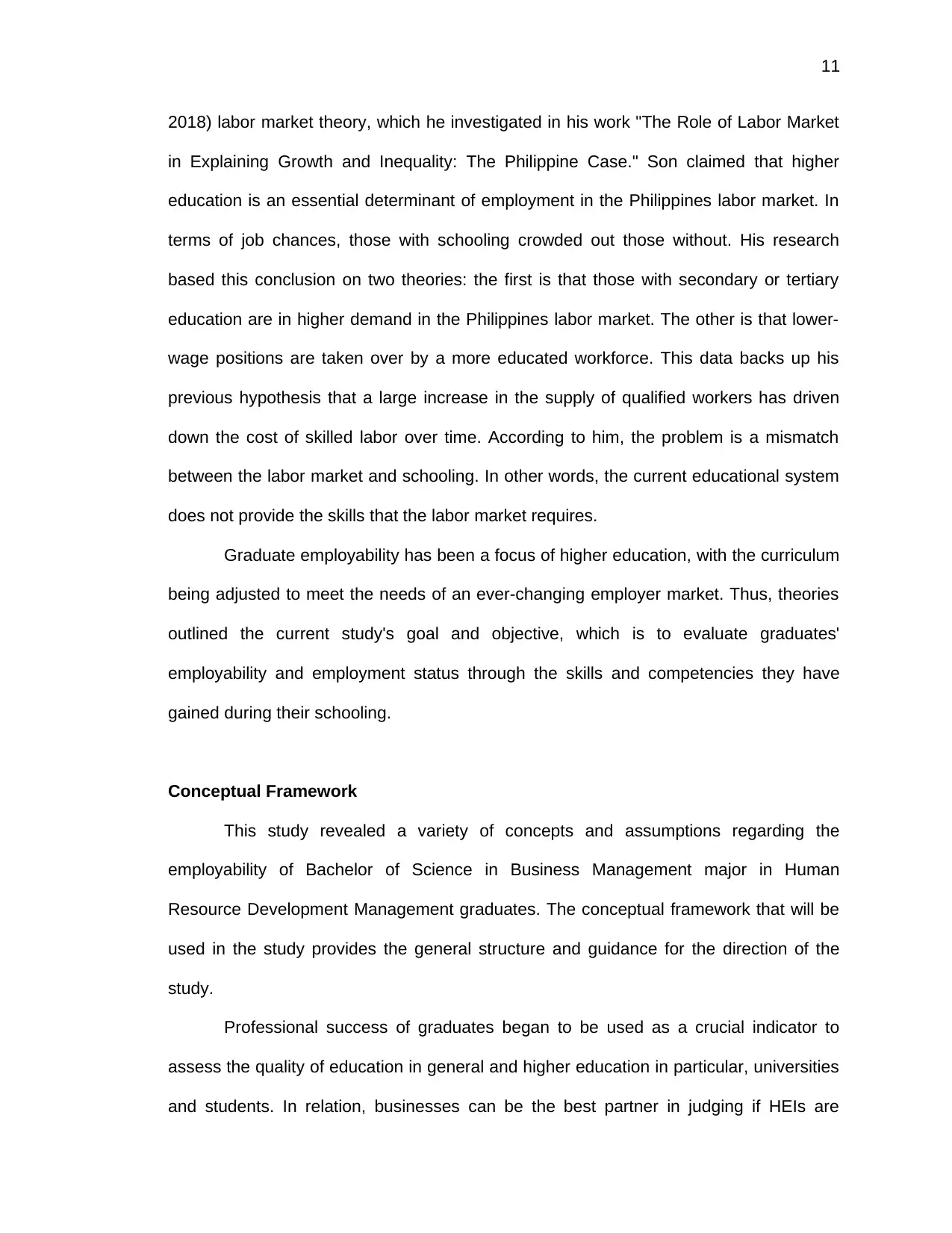
11
2018) labor market theory, which he investigated in his work "The Role of Labor Market
in Explaining Growth and Inequality: The Philippine Case." Son claimed that higher
education is an essential determinant of employment in the Philippines labor market. In
terms of job chances, those with schooling crowded out those without. His research
based this conclusion on two theories: the first is that those with secondary or tertiary
education are in higher demand in the Philippines labor market. The other is that lower-
wage positions are taken over by a more educated workforce. This data backs up his
previous hypothesis that a large increase in the supply of qualified workers has driven
down the cost of skilled labor over time. According to him, the problem is a mismatch
between the labor market and schooling. In other words, the current educational system
does not provide the skills that the labor market requires.
Graduate employability has been a focus of higher education, with the curriculum
being adjusted to meet the needs of an ever-changing employer market. Thus, theories
outlined the current study's goal and objective, which is to evaluate graduates'
employability and employment status through the skills and competencies they have
gained during their schooling.
Conceptual Framework
This study revealed a variety of concepts and assumptions regarding the
employability of Bachelor of Science in Business Management major in Human
Resource Development Management graduates. The conceptual framework that will be
used in the study provides the general structure and guidance for the direction of the
study.
Professional success of graduates began to be used as a crucial indicator to
assess the quality of education in general and higher education in particular, universities
and students. In relation, businesses can be the best partner in judging if HEIs are
2018) labor market theory, which he investigated in his work "The Role of Labor Market
in Explaining Growth and Inequality: The Philippine Case." Son claimed that higher
education is an essential determinant of employment in the Philippines labor market. In
terms of job chances, those with schooling crowded out those without. His research
based this conclusion on two theories: the first is that those with secondary or tertiary
education are in higher demand in the Philippines labor market. The other is that lower-
wage positions are taken over by a more educated workforce. This data backs up his
previous hypothesis that a large increase in the supply of qualified workers has driven
down the cost of skilled labor over time. According to him, the problem is a mismatch
between the labor market and schooling. In other words, the current educational system
does not provide the skills that the labor market requires.
Graduate employability has been a focus of higher education, with the curriculum
being adjusted to meet the needs of an ever-changing employer market. Thus, theories
outlined the current study's goal and objective, which is to evaluate graduates'
employability and employment status through the skills and competencies they have
gained during their schooling.
Conceptual Framework
This study revealed a variety of concepts and assumptions regarding the
employability of Bachelor of Science in Business Management major in Human
Resource Development Management graduates. The conceptual framework that will be
used in the study provides the general structure and guidance for the direction of the
study.
Professional success of graduates began to be used as a crucial indicator to
assess the quality of education in general and higher education in particular, universities
and students. In relation, businesses can be the best partner in judging if HEIs are
⊘ This is a preview!⊘
Do you want full access?
Subscribe today to unlock all pages.

Trusted by 1+ million students worldwide
1 out of 48
Your All-in-One AI-Powered Toolkit for Academic Success.
+13062052269
info@desklib.com
Available 24*7 on WhatsApp / Email
![[object Object]](/_next/static/media/star-bottom.7253800d.svg)
Unlock your academic potential
Copyright © 2020–2025 A2Z Services. All Rights Reserved. Developed and managed by ZUCOL.